2006 MERCEDES-BENZ SPRINTER engine
[x] Cancel search: enginePage 2259 of 2305
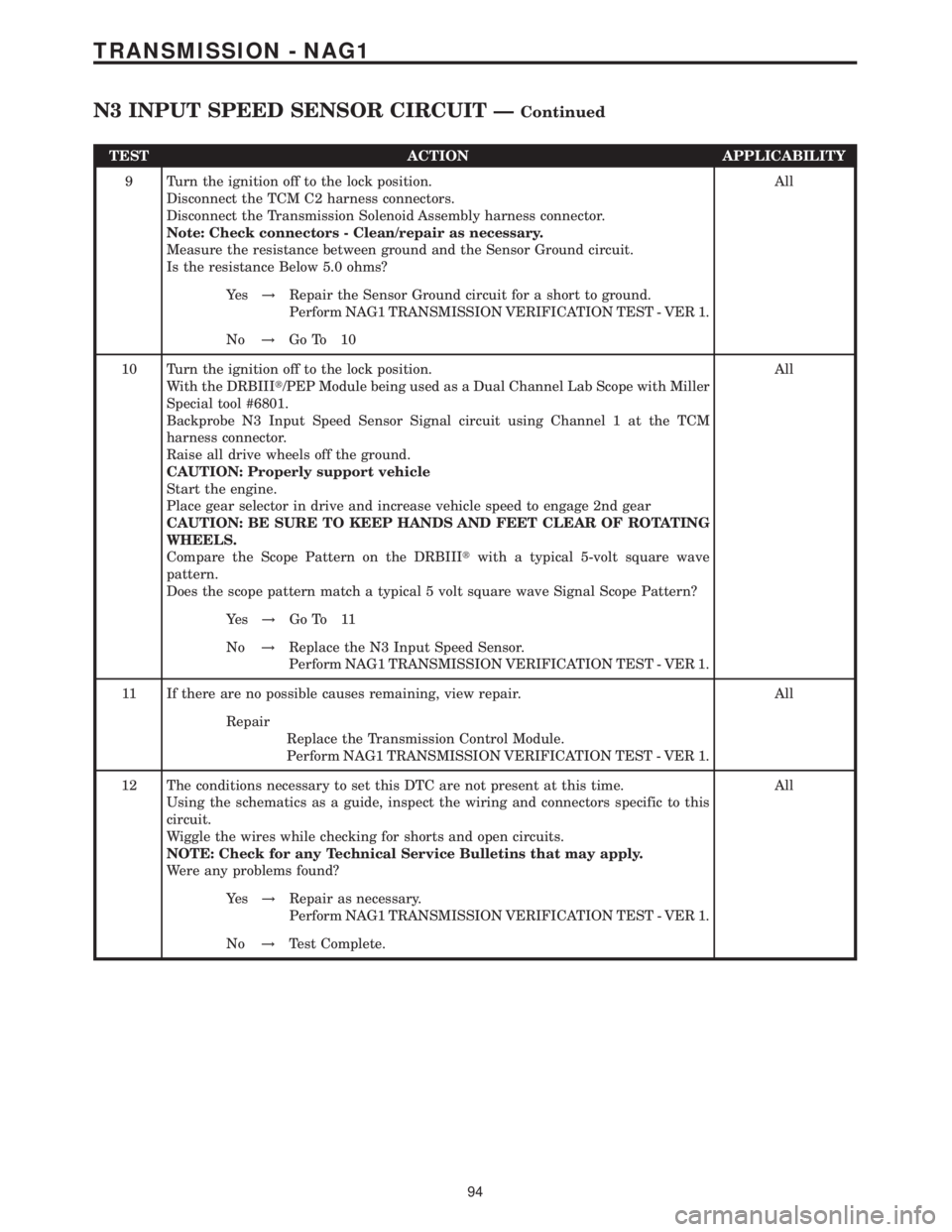
TEST ACTION APPLICABILITY
9 Turn the ignition off to the lock position.
Disconnect the TCM C2 harness connectors.
Disconnect the Transmission Solenoid Assembly harness connector.
Note: Check connectors - Clean/repair as necessary.
Measure the resistance between ground and the Sensor Ground circuit.
Is the resistance Below 5.0 ohms?All
Ye s!Repair the Sensor Ground circuit for a short to ground.
Perform NAG1 TRANSMISSION VERIFICATION TEST - VER 1.
No!Go To 10
10 Turn the ignition off to the lock position.
With the DRBIIIt/PEP Module being used as a Dual Channel Lab Scope with Miller
Special tool #6801.
Backprobe N3 Input Speed Sensor Signal circuit using Channel 1 at the TCM
harness connector.
Raise all drive wheels off the ground.
CAUTION: Properly support vehicle
Start the engine.
Place gear selector in drive and increase vehicle speed to engage 2nd gear
CAUTION: BE SURE TO KEEP HANDS AND FEET CLEAR OF ROTATING
WHEELS.
Compare the Scope Pattern on the DRBIIItwith a typical 5-volt square wave
pattern.
Does the scope pattern match a typical 5 volt square wave Signal Scope Pattern?All
Ye s!Go To 11
No!Replace the N3 Input Speed Sensor.
Perform NAG1 TRANSMISSION VERIFICATION TEST - VER 1.
11 If there are no possible causes remaining, view repair. All
Repair
Replace the Transmission Control Module.
Perform NAG1 TRANSMISSION VERIFICATION TEST - VER 1.
12 The conditions necessary to set this DTC are not present at this time.
Using the schematics as a guide, inspect the wiring and connectors specific to this
circuit.
Wiggle the wires while checking for shorts and open circuits.
NOTE: Check for any Technical Service Bulletins that may apply.
Were any problems found?All
Ye s!Repair as necessary.
Perform NAG1 TRANSMISSION VERIFICATION TEST - VER 1.
No!Test Complete.
94
TRANSMISSION - NAG1
N3 INPUT SPEED SENSOR CIRCUIT ÐContinued
Page 2260 of 2305
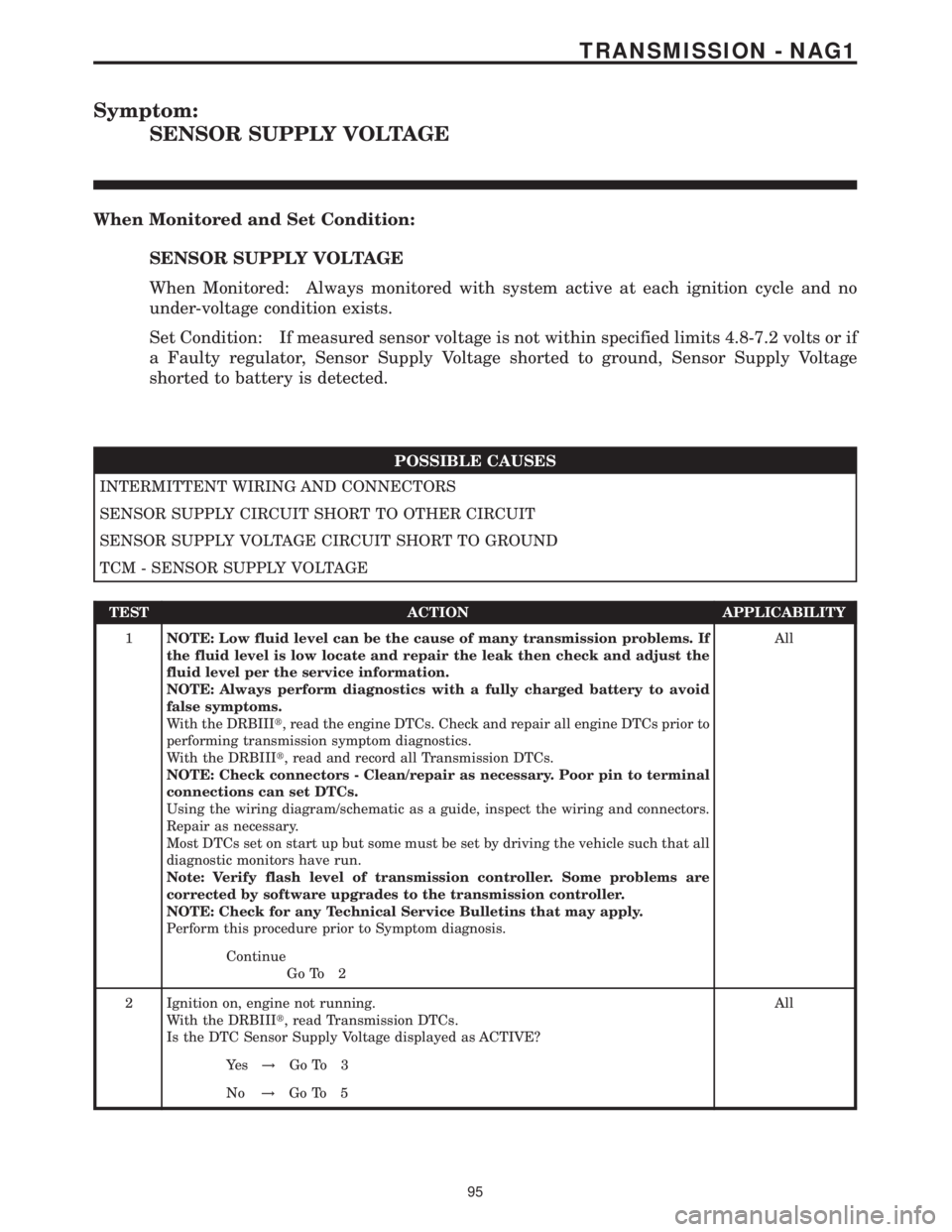
Symptom:
SENSOR SUPPLY VOLTAGE
When Monitored and Set Condition:
SENSOR SUPPLY VOLTAGE
When Monitored: Always monitored with system active at each ignition cycle and no
under-voltage condition exists.
Set Condition: If measured sensor voltage is not within specified limits 4.8-7.2 volts or if
a Faulty regulator, Sensor Supply Voltage shorted to ground, Sensor Supply Voltage
shorted to battery is detected.
POSSIBLE CAUSES
INTERMITTENT WIRING AND CONNECTORS
SENSOR SUPPLY CIRCUIT SHORT TO OTHER CIRCUIT
SENSOR SUPPLY VOLTAGE CIRCUIT SHORT TO GROUND
TCM - SENSOR SUPPLY VOLTAGE
TEST ACTION APPLICABILITY
1NOTE: Low fluid level can be the cause of many transmission problems. If
the fluid level is low locate and repair the leak then check and adjust the
fluid level per the service information.
NOTE: Always perform diagnostics with a fully charged battery to avoid
false symptoms.
With the DRBIIIt, read the engine DTCs. Check and repair all engine DTCs prior to
performing transmission symptom diagnostics.
With the DRBIIIt, read and record all Transmission DTCs.
NOTE: Check connectors - Clean/repair as necessary. Poor pin to terminal
connections can set DTCs.
Using the wiring diagram/schematic as a guide, inspect the wiring and connectors.
Repair as necessary.
Most DTCs set on start up but some must be set by driving the vehicle such that all
diagnostic monitors have run.
Note: Verify flash level of transmission controller. Some problems are
corrected by software upgrades to the transmission controller.
NOTE: Check for any Technical Service Bulletins that may apply.
Perform this procedure prior to Symptom diagnosis.All
Continue
Go To 2
2 Ignition on, engine not running.
With the DRBIIIt, read Transmission DTCs.
Is the DTC Sensor Supply Voltage displayed as ACTIVE?All
Ye s!Go To 3
No!Go To 5
95
TRANSMISSION - NAG1
Page 2262 of 2305
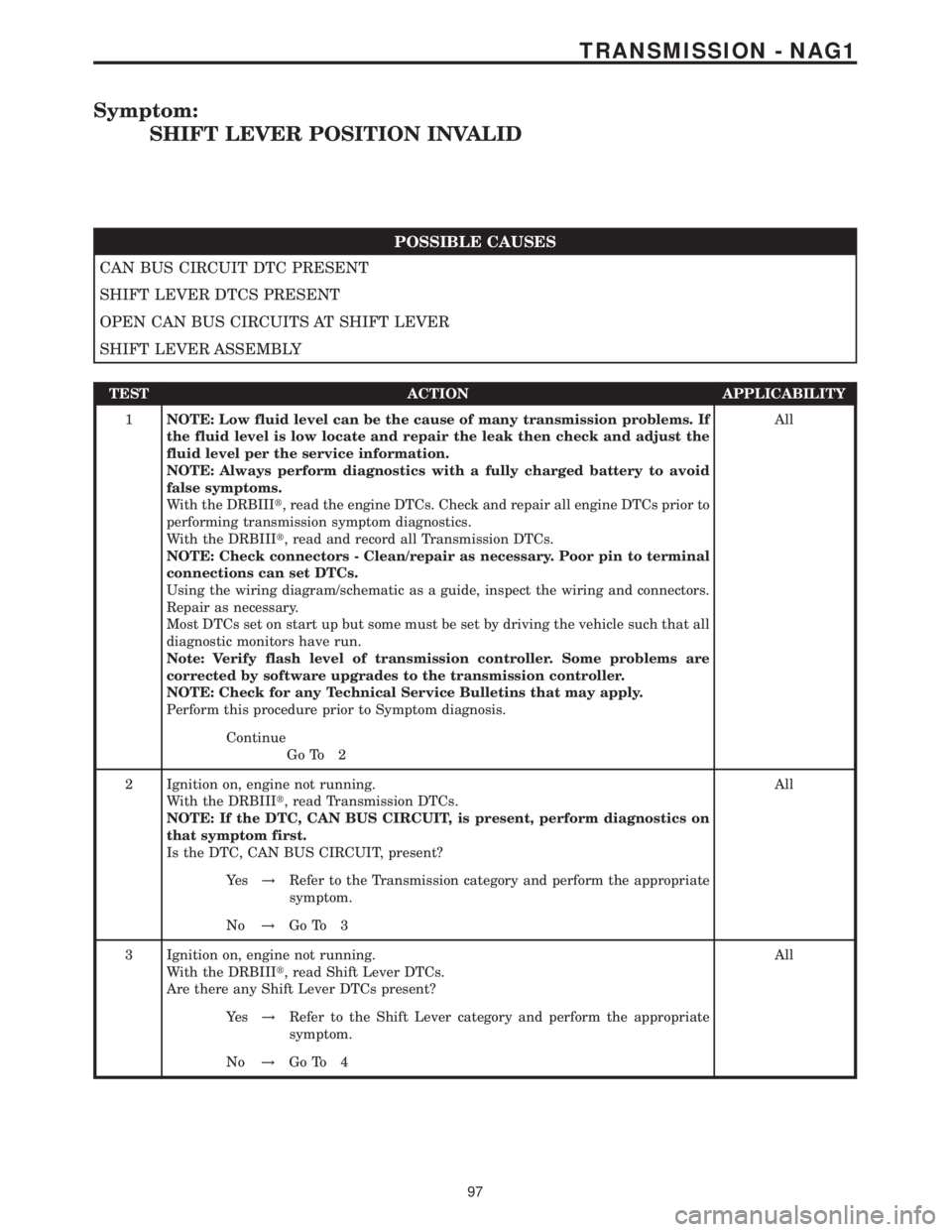
Symptom:
SHIFT LEVER POSITION INVALID
POSSIBLE CAUSES
CAN BUS CIRCUIT DTC PRESENT
SHIFT LEVER DTCS PRESENT
OPEN CAN BUS CIRCUITS AT SHIFT LEVER
SHIFT LEVER ASSEMBLY
TEST ACTION APPLICABILITY
1NOTE: Low fluid level can be the cause of many transmission problems. If
the fluid level is low locate and repair the leak then check and adjust the
fluid level per the service information.
NOTE: Always perform diagnostics with a fully charged battery to avoid
false symptoms.
With the DRBIIIt, read the engine DTCs. Check and repair all engine DTCs prior to
performing transmission symptom diagnostics.
With the DRBIIIt, read and record all Transmission DTCs.
NOTE: Check connectors - Clean/repair as necessary. Poor pin to terminal
connections can set DTCs.
Using the wiring diagram/schematic as a guide, inspect the wiring and connectors.
Repair as necessary.
Most DTCs set on start up but some must be set by driving the vehicle such that all
diagnostic monitors have run.
Note: Verify flash level of transmission controller. Some problems are
corrected by software upgrades to the transmission controller.
NOTE: Check for any Technical Service Bulletins that may apply.
Perform this procedure prior to Symptom diagnosis.All
Continue
Go To 2
2 Ignition on, engine not running.
With the DRBIIIt, read Transmission DTCs.
NOTE: If the DTC, CAN BUS CIRCUIT, is present, perform diagnostics on
that symptom first.
Is the DTC, CAN BUS CIRCUIT, present?All
Ye s!Refer to the Transmission category and perform the appropriate
symptom.
No!Go To 3
3 Ignition on, engine not running.
With the DRBIIIt, read Shift Lever DTCs.
Are there any Shift Lever DTCs present?All
Ye s!Refer to the Shift Lever category and perform the appropriate
symptom.
No!Go To 4
97
TRANSMISSION - NAG1
Page 2264 of 2305
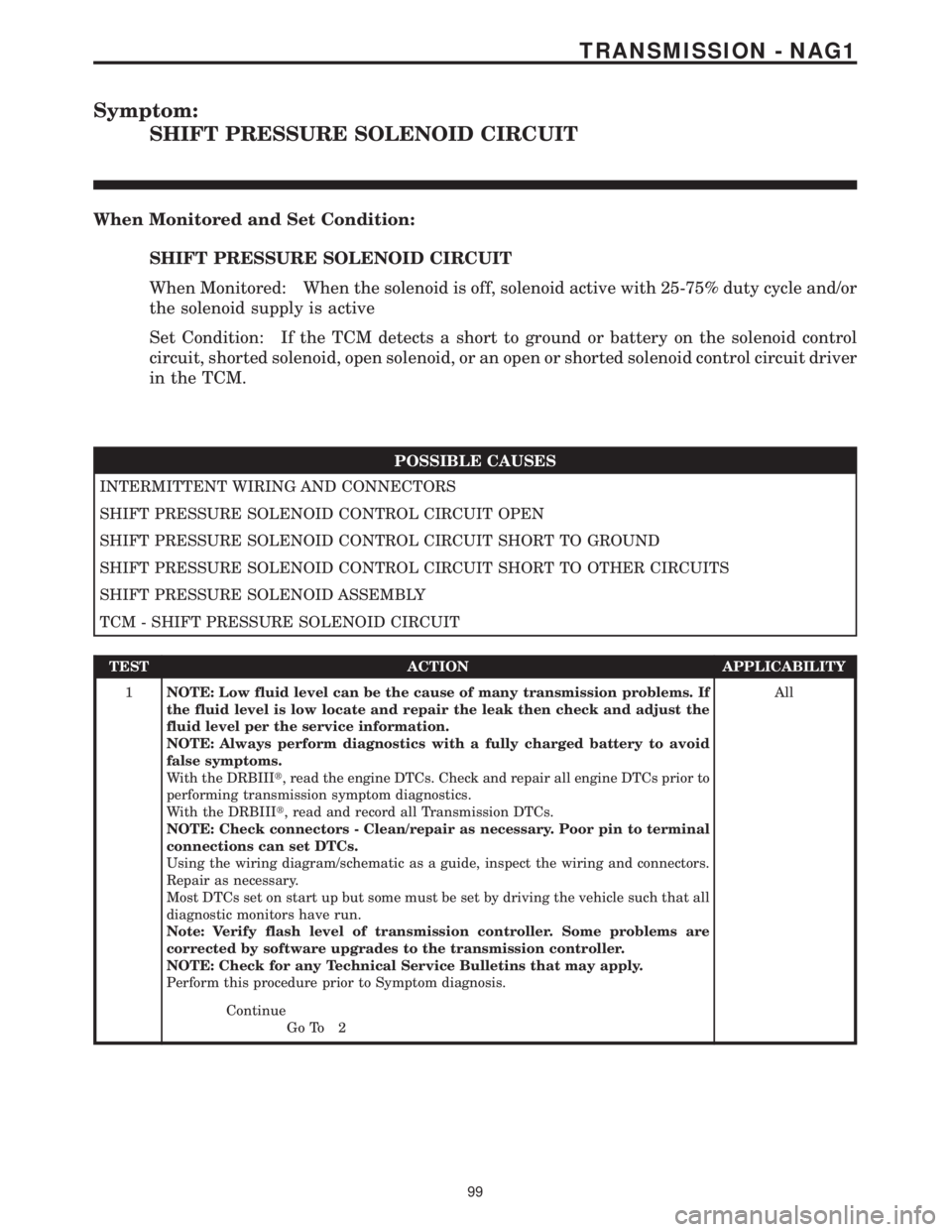
Symptom:
SHIFT PRESSURE SOLENOID CIRCUIT
When Monitored and Set Condition:
SHIFT PRESSURE SOLENOID CIRCUIT
When Monitored: When the solenoid is off, solenoid active with 25-75% duty cycle and/or
the solenoid supply is active
Set Condition: If the TCM detects a short to ground or battery on the solenoid control
circuit, shorted solenoid, open solenoid, or an open or shorted solenoid control circuit driver
in the TCM.
POSSIBLE CAUSES
INTERMITTENT WIRING AND CONNECTORS
SHIFT PRESSURE SOLENOID CONTROL CIRCUIT OPEN
SHIFT PRESSURE SOLENOID CONTROL CIRCUIT SHORT TO GROUND
SHIFT PRESSURE SOLENOID CONTROL CIRCUIT SHORT TO OTHER CIRCUITS
SHIFT PRESSURE SOLENOID ASSEMBLY
TCM - SHIFT PRESSURE SOLENOID CIRCUIT
TEST ACTION APPLICABILITY
1NOTE: Low fluid level can be the cause of many transmission problems. If
the fluid level is low locate and repair the leak then check and adjust the
fluid level per the service information.
NOTE: Always perform diagnostics with a fully charged battery to avoid
false symptoms.
With the DRBIIIt, read the engine DTCs. Check and repair all engine DTCs prior to
performing transmission symptom diagnostics.
With the DRBIIIt, read and record all Transmission DTCs.
NOTE: Check connectors - Clean/repair as necessary. Poor pin to terminal
connections can set DTCs.
Using the wiring diagram/schematic as a guide, inspect the wiring and connectors.
Repair as necessary.
Most DTCs set on start up but some must be set by driving the vehicle such that all
diagnostic monitors have run.
Note: Verify flash level of transmission controller. Some problems are
corrected by software upgrades to the transmission controller.
NOTE: Check for any Technical Service Bulletins that may apply.
Perform this procedure prior to Symptom diagnosis.All
Continue
Go To 2
99
TRANSMISSION - NAG1
Page 2265 of 2305
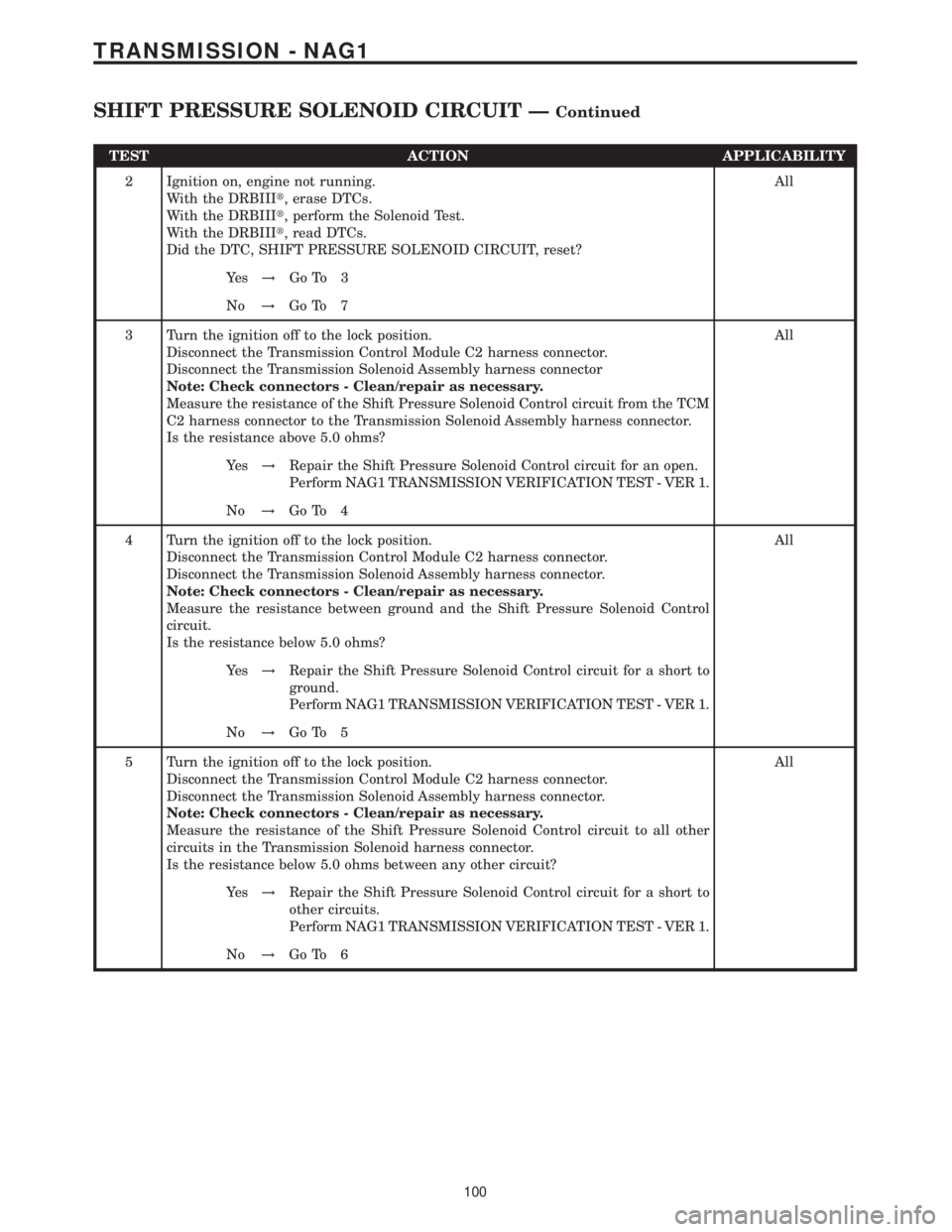
TEST ACTION APPLICABILITY
2 Ignition on, engine not running.
With the DRBIIIt, erase DTCs.
With the DRBIIIt, perform the Solenoid Test.
With the DRBIIIt, read DTCs.
Did the DTC, SHIFT PRESSURE SOLENOID CIRCUIT, reset?All
Ye s!Go To 3
No!Go To 7
3 Turn the ignition off to the lock position.
Disconnect the Transmission Control Module C2 harness connector.
Disconnect the Transmission Solenoid Assembly harness connector
Note: Check connectors - Clean/repair as necessary.
Measure the resistance of the Shift Pressure Solenoid Control circuit from the TCM
C2 harness connector to the Transmission Solenoid Assembly harness connector.
Is the resistance above 5.0 ohms?All
Ye s!Repair the Shift Pressure Solenoid Control circuit for an open.
Perform NAG1 TRANSMISSION VERIFICATION TEST - VER 1.
No!Go To 4
4 Turn the ignition off to the lock position.
Disconnect the Transmission Control Module C2 harness connector.
Disconnect the Transmission Solenoid Assembly harness connector.
Note: Check connectors - Clean/repair as necessary.
Measure the resistance between ground and the Shift Pressure Solenoid Control
circuit.
Is the resistance below 5.0 ohms?All
Ye s!Repair the Shift Pressure Solenoid Control circuit for a short to
ground.
Perform NAG1 TRANSMISSION VERIFICATION TEST - VER 1.
No!Go To 5
5 Turn the ignition off to the lock position.
Disconnect the Transmission Control Module C2 harness connector.
Disconnect the Transmission Solenoid Assembly harness connector.
Note: Check connectors - Clean/repair as necessary.
Measure the resistance of the Shift Pressure Solenoid Control circuit to all other
circuits in the Transmission Solenoid harness connector.
Is the resistance below 5.0 ohms between any other circuit?All
Ye s!Repair the Shift Pressure Solenoid Control circuit for a short to
other circuits.
Perform NAG1 TRANSMISSION VERIFICATION TEST - VER 1.
No!Go To 6
100
TRANSMISSION - NAG1
SHIFT PRESSURE SOLENOID CIRCUIT ÐContinued
Page 2267 of 2305
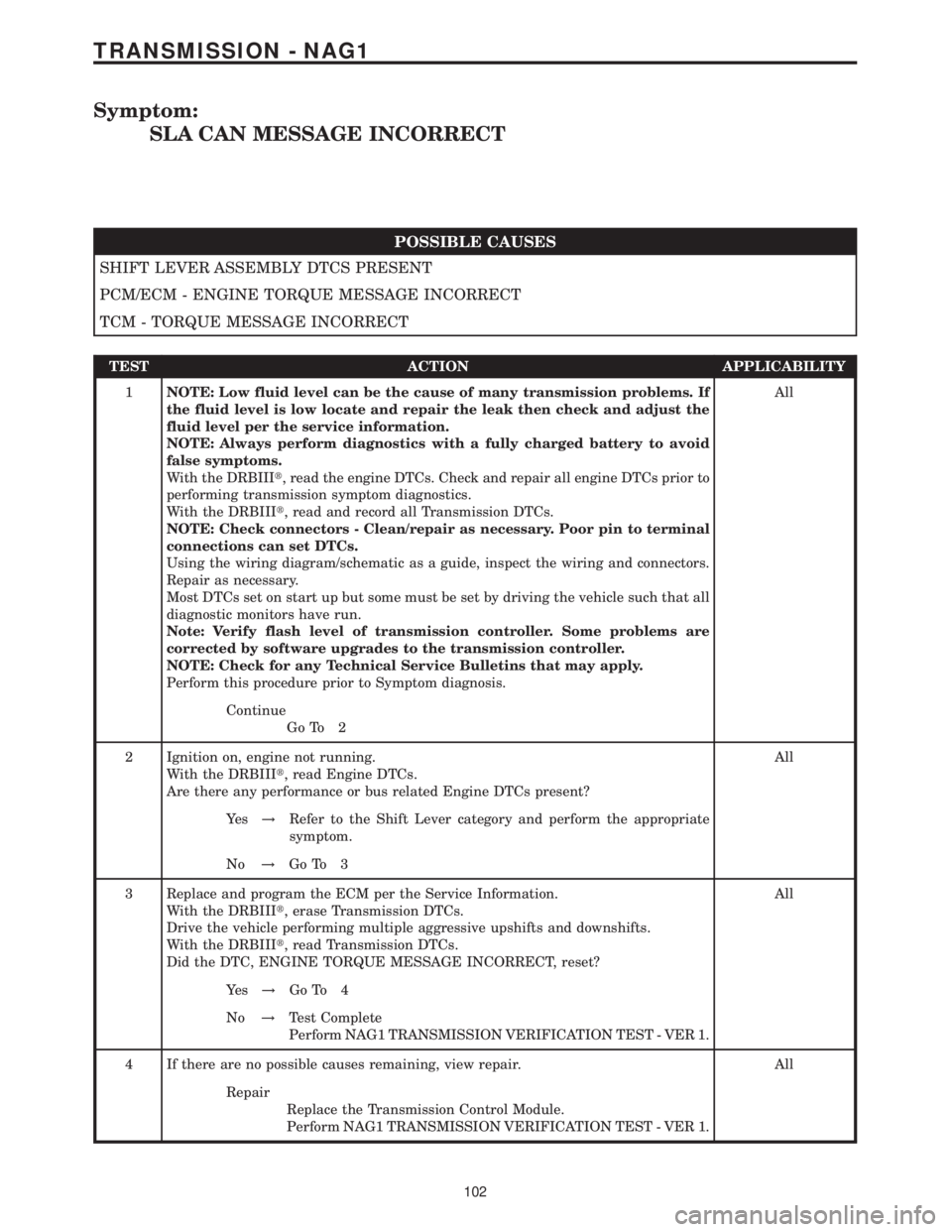
Symptom:
SLA CAN MESSAGE INCORRECT
POSSIBLE CAUSES
SHIFT LEVER ASSEMBLY DTCS PRESENT
PCM/ECM - ENGINE TORQUE MESSAGE INCORRECT
TCM - TORQUE MESSAGE INCORRECT
TEST ACTION APPLICABILITY
1NOTE: Low fluid level can be the cause of many transmission problems. If
the fluid level is low locate and repair the leak then check and adjust the
fluid level per the service information.
NOTE: Always perform diagnostics with a fully charged battery to avoid
false symptoms.
With the DRBIIIt, read the engine DTCs. Check and repair all engine DTCs prior to
performing transmission symptom diagnostics.
With the DRBIIIt, read and record all Transmission DTCs.
NOTE: Check connectors - Clean/repair as necessary. Poor pin to terminal
connections can set DTCs.
Using the wiring diagram/schematic as a guide, inspect the wiring and connectors.
Repair as necessary.
Most DTCs set on start up but some must be set by driving the vehicle such that all
diagnostic monitors have run.
Note: Verify flash level of transmission controller. Some problems are
corrected by software upgrades to the transmission controller.
NOTE: Check for any Technical Service Bulletins that may apply.
Perform this procedure prior to Symptom diagnosis.All
Continue
Go To 2
2 Ignition on, engine not running.
With the DRBIIIt, read Engine DTCs.
Are there any performance or bus related Engine DTCs present?All
Ye s!Refer to the Shift Lever category and perform the appropriate
symptom.
No!Go To 3
3 Replace and program the ECM per the Service Information.
With the DRBIIIt, erase Transmission DTCs.
Drive the vehicle performing multiple aggressive upshifts and downshifts.
With the DRBIIIt, read Transmission DTCs.
Did the DTC, ENGINE TORQUE MESSAGE INCORRECT, reset?All
Ye s!Go To 4
No!Test Complete
Perform NAG1 TRANSMISSION VERIFICATION TEST - VER 1.
4 If there are no possible causes remaining, view repair. All
Repair
Replace the Transmission Control Module.
Perform NAG1 TRANSMISSION VERIFICATION TEST - VER 1.
102
TRANSMISSION - NAG1
Page 2268 of 2305
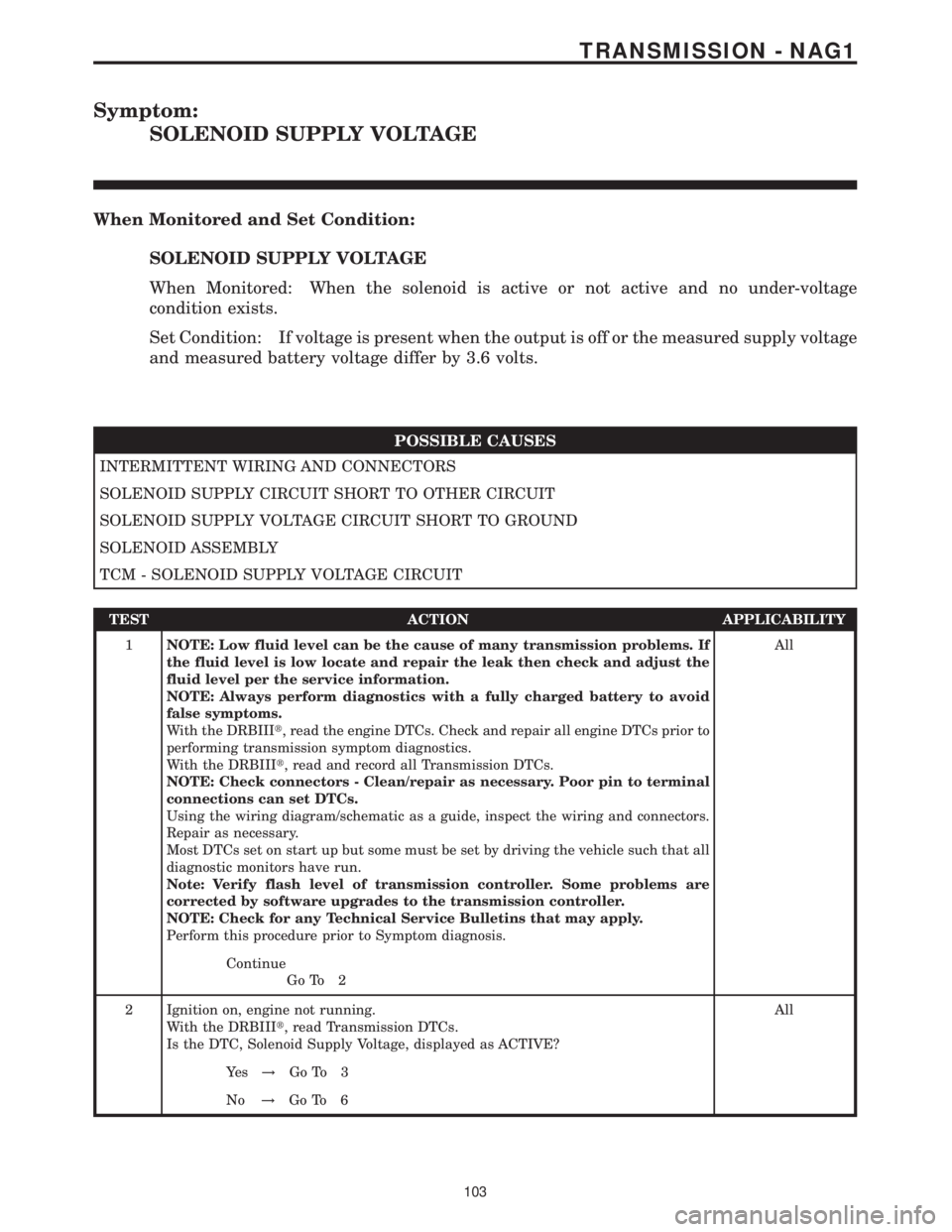
Symptom:
SOLENOID SUPPLY VOLTAGE
When Monitored and Set Condition:
SOLENOID SUPPLY VOLTAGE
When Monitored: When the solenoid is active or not active and no under-voltage
condition exists.
Set Condition: If voltage is present when the output is off or the measured supply voltage
and measured battery voltage differ by 3.6 volts.
POSSIBLE CAUSES
INTERMITTENT WIRING AND CONNECTORS
SOLENOID SUPPLY CIRCUIT SHORT TO OTHER CIRCUIT
SOLENOID SUPPLY VOLTAGE CIRCUIT SHORT TO GROUND
SOLENOID ASSEMBLY
TCM - SOLENOID SUPPLY VOLTAGE CIRCUIT
TEST ACTION APPLICABILITY
1NOTE: Low fluid level can be the cause of many transmission problems. If
the fluid level is low locate and repair the leak then check and adjust the
fluid level per the service information.
NOTE: Always perform diagnostics with a fully charged battery to avoid
false symptoms.
With the DRBIIIt, read the engine DTCs. Check and repair all engine DTCs prior to
performing transmission symptom diagnostics.
With the DRBIIIt, read and record all Transmission DTCs.
NOTE: Check connectors - Clean/repair as necessary. Poor pin to terminal
connections can set DTCs.
Using the wiring diagram/schematic as a guide, inspect the wiring and connectors.
Repair as necessary.
Most DTCs set on start up but some must be set by driving the vehicle such that all
diagnostic monitors have run.
Note: Verify flash level of transmission controller. Some problems are
corrected by software upgrades to the transmission controller.
NOTE: Check for any Technical Service Bulletins that may apply.
Perform this procedure prior to Symptom diagnosis.All
Continue
Go To 2
2 Ignition on, engine not running.
With the DRBIIIt, read Transmission DTCs.
Is the DTC, Solenoid Supply Voltage, displayed as ACTIVE?All
Ye s!Go To 3
No!Go To 6
103
TRANSMISSION - NAG1
Page 2270 of 2305
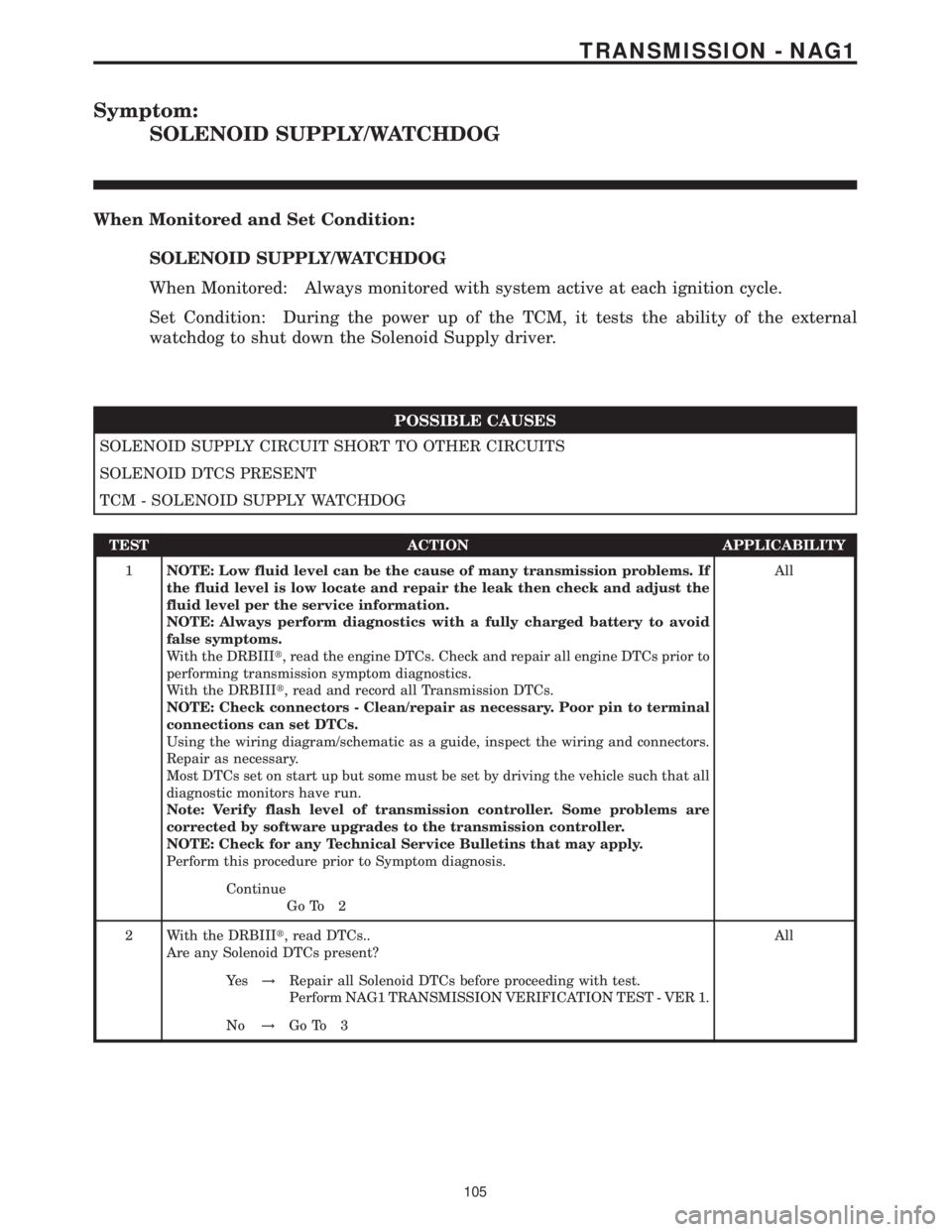
Symptom:
SOLENOID SUPPLY/WATCHDOG
When Monitored and Set Condition:
SOLENOID SUPPLY/WATCHDOG
When Monitored: Always monitored with system active at each ignition cycle.
Set Condition: During the power up of the TCM, it tests the ability of the external
watchdog to shut down the Solenoid Supply driver.
POSSIBLE CAUSES
SOLENOID SUPPLY CIRCUIT SHORT TO OTHER CIRCUITS
SOLENOID DTCS PRESENT
TCM - SOLENOID SUPPLY WATCHDOG
TEST ACTION APPLICABILITY
1NOTE: Low fluid level can be the cause of many transmission problems. If
the fluid level is low locate and repair the leak then check and adjust the
fluid level per the service information.
NOTE: Always perform diagnostics with a fully charged battery to avoid
false symptoms.
With the DRBIIIt, read the engine DTCs. Check and repair all engine DTCs prior to
performing transmission symptom diagnostics.
With the DRBIIIt, read and record all Transmission DTCs.
NOTE: Check connectors - Clean/repair as necessary. Poor pin to terminal
connections can set DTCs.
Using the wiring diagram/schematic as a guide, inspect the wiring and connectors.
Repair as necessary.
Most DTCs set on start up but some must be set by driving the vehicle such that all
diagnostic monitors have run.
Note: Verify flash level of transmission controller. Some problems are
corrected by software upgrades to the transmission controller.
NOTE: Check for any Technical Service Bulletins that may apply.
Perform this procedure prior to Symptom diagnosis.All
Continue
Go To 2
2 With the DRBIIIt, read DTCs..
Are any Solenoid DTCs present?All
Ye s!Repair all Solenoid DTCs before proceeding with test.
Perform NAG1 TRANSMISSION VERIFICATION TEST - VER 1.
No!Go To 3
105
TRANSMISSION - NAG1